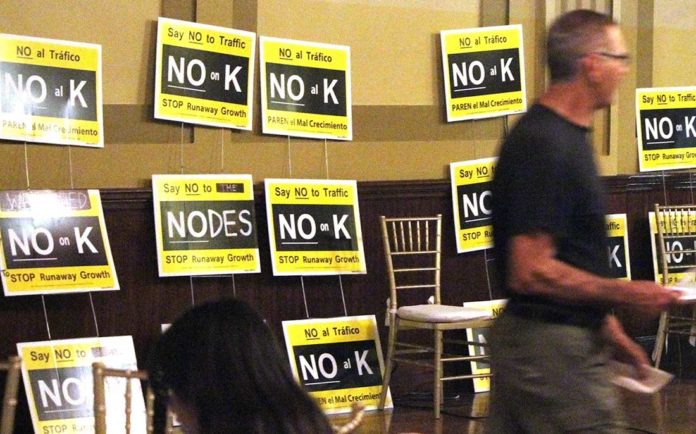Opponents of Measure K celebrated on election night, confident that early returns would hold up—and they did, as the commercial rezoning of four Highway 101 interchanges was headed for defeat.
As of 10pm March 3, 59 percent voted ‘No’ on the measure, outnumbering the affirmative votes by 1,740 votes.
Measure K would adopt an ordinance approved unanimously by county supervisors in September that converts four properties at highway interchanges to regional commercial zoning.
A successful signature-gathering campaign by citizens group Preserve Our Rural Communities halted the ordinance’s implementation, and put the question on the March ballot.
The four interchanges outlined in the ordinance are the Betabel Road and Highway 129/Searle Road interchanges in San Juan Bautista, and the Rocks Ranch and 101 Livestock Market interchanges in Aromas. The four properties, totaling about 326 acres and known as “nodes,” would be converted to regional commercial zoning, which according to the 2035 General Plan approved in 2015, provides “areas that function as destinations for commercial activity serving the regional population.”
The types of developments allowed are shopping centers, automobile stations and hotels. Under regional commercial “C-3” zoning, retail space is limited to 85,000 square feet per property.
Aromas resident Andy Hsia-Coron of Preserve Our Rural Communities said opponents of the measure were confident it would be defeated.
“We talked to thousands of people, and we had the impression that we were going to get somewhere around 60 percent,” he said. “There’s a series of issues that made some difference. Certainly traffic and the issue that growth is out of control and the infrastructure currently can’t handle what is going on.”
His wife, Mary Hsia-Coron, who is also active in the group, said county residents “are realizing that development has not been good for our community.”
“I think people have been feeling that our supervisors and other elected officials have not been listening to the people,” she said.
Supervisor Anthony Botelho, whose district covers the areas where the nodes are located, said he was disappointed but not surprised at the results, noting that opponents had spread misinformation to the public about the zoning ordinance.
“It’s a devastating loss to the citizens of the county in the way of potential improvement of services and fixing roads, without raising taxes,” he said. “But at the end of the day, we weren’t able to get that message out and we weren’t successful at the ballot box.”
Owners of the properties along Highway 101 can still apply for another commercial zoning designation, known as “C-1.”
The C-1 zoning is “nowhere near as restrictive,” Botelho said, and opens up other areas within the general area of the nodes for potential development.
“In the General Plan, a node is an unspecific area,” he said. “In C-3, we were going to restrict it and identify it. That’s a big, big difference.”
A C-1 zoning change for the Betabel property was recommended by the county planning commission in November, and Botelho expects it to come before the board of supervisors in late March.
Nearly $90,000 had been raised through Feb. 15 in the campaigns surrounding Measure K.
The largest contributors to the Yes on Measure K campaign were owners or representatives of property that could potentially benefit from the rezoning.
The 2004 Bingaman Irrevocable Trust, owner of the Rocks Ranch property along Highway 101, contributed $22,000 to the Yes on Measure K campaign committee. An entity called Livestock 101 contributed $15,000 and two lawyers, Gregory Weiler and Mark Johnson, each contributed $11,000 to the campaign.
The opponents of the rezoning raised $20,232 through Feb. 15, and the biggest contributors to the Preserve Our Rural Communities committee were individuals: Ruth Snow, $2,000; Thomas Karis, $1,610; Christopher Wilmers, $1,000; Josh Jensen, $1,000; and Sara Steiner, $750.
With the apparent defeat of Measure K, Preserve Our Rural Communities is riding the momentum with its other two initiatives. The group on March 2 submitted a petition that could establish an urban growth boundary around the City of Hollister, and is currently gathering signatures for a second initiative that would put rezoning of county agricultural lands in the hands of voters.










